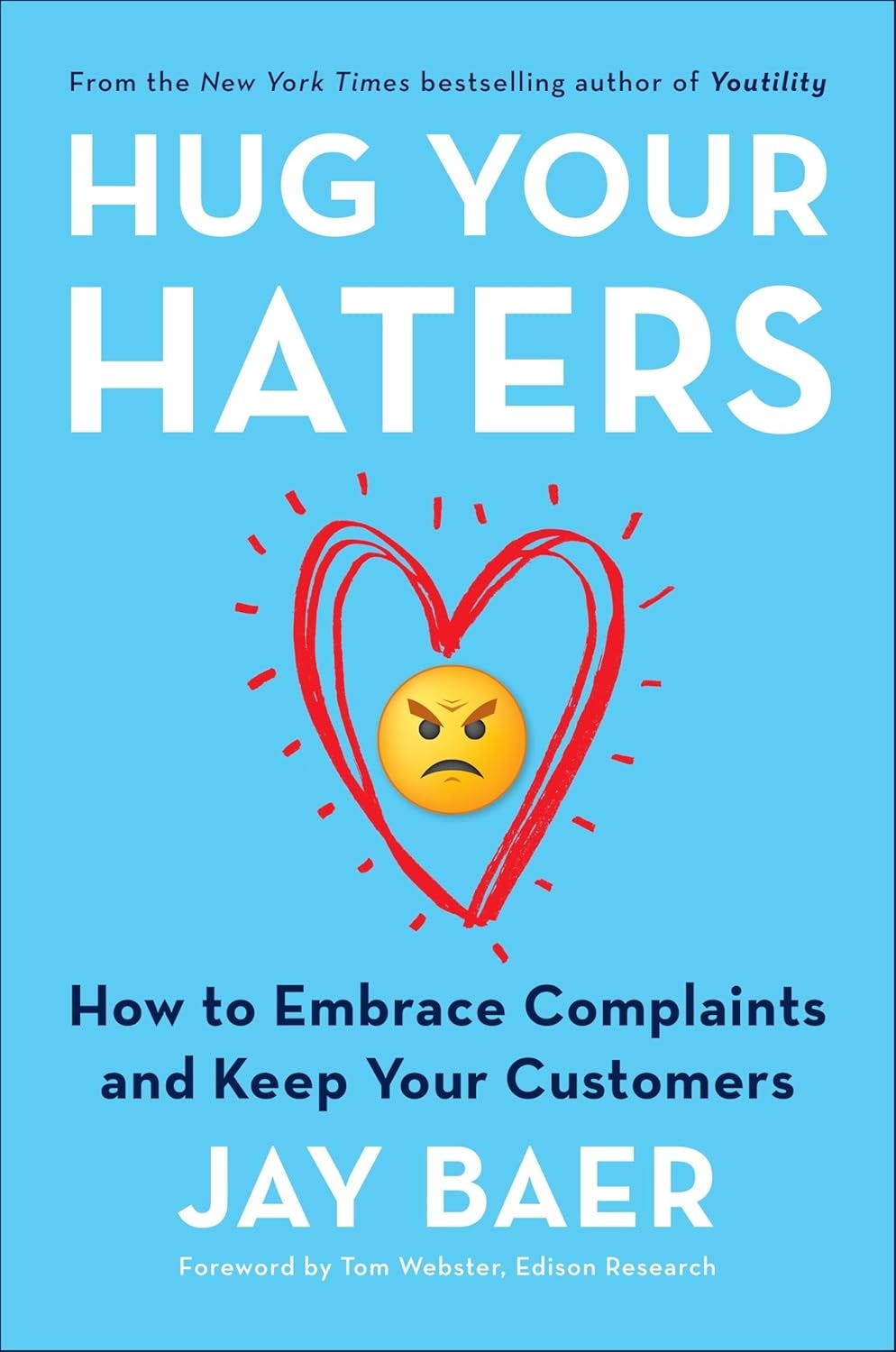I wasn’t going to talk about Taylor Swift this week, because, you know, everyone is talking about Taylor Swift because of that thing. But I’m going to talk about Taylor Swift because we’re talking about haters.
And boy does girlfriend have some haters.
She goes on a tour to end all tours. She infuses millions into the economies of every city she tours in. She donates tons and tons of supplies to food banks. She’s got a wholesome relationship with a football player whose games she goes to with his mom. Her engagement is making people lose their minds. And people still hate her.
The point is that people are ridiculous, and the point is also that you can’t win. If you exist, there will be someone who hates you for it.
Normally, I’d say to shake it off, but it becomes inconvenient when you’re trying to win over an organization to adopt the change you’re trying to make—not to mention, emotionally draining. It’s a little bit of a gut punch to realize that not only do people not like your ideas, and not only do they not like you, but they actively hate you.
If you’re going to lead change, people are going to hate it. And you. But there are plenty of positive ways to deal with that.
Let’s decode it. 🚀
Okay, fine, just one more Taylor reference. I’m done now.
Every change-maker collects critics
But it’s how you deal with them that matters.
If you’re leading change, you’re going to collect critics. It’s not a question of if, but when.
Sometimes, it’s disgruntled people in the ranks. Sometimes, it’s people above you. And I think those were the ones that rattled me the most—when I had very senior Army leaders coming for me for the work I was doing (work approved by my chain of command, I will add). I thought, “If these people are angry, I must have done something seriously wrong.”
But when you change things that are tightly woven into a culture, when you challenge ideas that people have relied on as truth, they react emotionally. Viscerally. Even if it’s just criticism you face, the presence of critics often means you’re making ripples in a system designed to resist them. Silence is a worse warning sign than opposition.
The question isn’t whether you’ll get pushback, criticism, or even haters when you’re leading change. It’s whether or not you’ll let the haters write your story, or whether you’ll own it yourself.
Not All Criticism Is Equal
The first step in dealing with opposition is learning to sort the signal from the noise.
Constructive Feedback: Honest, specific, and offered in the spirit of improvement—even if it stings. These are the comments you should listen to and lean into. They reveal your blind spots, sharpen your ideas, and sometimes even save you from making a fool of yourself.
Personal Attacks: Vague, hostile, or ad hominem. They say more about the critic than about you. These are the comments you, in engineer parlance, mark and bypass. They will happen, but just remember, they’re not about you, not really.
Political Resistance: In the Pentagon, we jokingly refer to this as “palace intrigue.” This is pushback rooted not in your idea’s merit but in its implications for power, influence, access to resources, or control. These require careful navigation. Sometimes you can compromise. Sometimes you have to stand firm. Sometimes you need to outlast the moment.
When you lump all criticism together, it becomes overwhelming. When you parse it, you can respond strategically instead of reactively.
Maintaining Professionalism in Public
When you’re challenged openly—whether in a meeting, an email chain, social media, or even on a stage—it’s tempting to go on the offensive. After all, you’ve worked hard, you believe in your vision, and you don’t want it undermined in real time.
But here’s the thing: your audience isn’t just the critic. It’s everyone out there who’s watching how you respond.
A few rules I’ve found helpful:
Stay Calm – Your composure is more memorable than your words. Even if your heart rate spikes, slow your voice and body language. If they make you angry, they’ve already upset your concentration. Don’t give them a point right at the bell.
Acknowledge the Concern – Without conceding the point, show that you heard them: “That’s an important perspective.” If it’s a justified concern, bring them into the conversation: “My team has been chewing on this, too.”
Pivot to the Purpose – Redirect the conversation back to shared goals: “What we both want is to improve readiness.” Offer them a way to follow up and help meet that shared goal, whether it’s providing feedback or a future conversation.
Defer if Needed – If the conversation is going nowhere, table it and move on. Bring it back to the original point of the conversation. It shows maturity and prevents derailment.
Every time you demonstrate grace under fire, you build credibility—even if you don’t win the argument in the moment. This sounds counterintuitive, but you don’t have to “win” to win; a good strategist anchors trust for future engagements.
Leveraging Critics as Allies
Not all critics stay critics. Some become your most valuable allies—if you engage them well.
I’ve seen this play out countless times. A skeptic becomes a tester, a tester becomes a contributor, and eventually, a former opponent becomes a champion. But that only happens if you resist the urge to write them off too quickly.
It’s all about shifting the dynamic, and reaching consensus on Rule 3 above—the shared goals. If you and your critics can at least agree you’re trying to move the organization in the same direction, even if you disagree on means, that’s something.
Use that as an anchor to figure out the differences.
Invite Input: Ask for their perspective early. Even if they disagree, involvement reduces the sense of being sidelined or undermined.
Be Transparent: Don’t hide what you’re doing. Often, if people understand where you’re going, it smooths out a lot of their concerns, and you’re left with one or two tactical changes you can make to gain more buy-in. Maybe you’ll never totally agree, but a shared understanding does a lot.
Give Them a Role: Sometimes critics push hardest because they feel excluded. Giving them responsibility reframes them as stakeholders.
Of course, not every critic can or should be converted. But some can—and those are wins worth pursuing.
My favorite resource for this is Jay Baer’s Hug Your Haters: How to Embrace Complaints and Keep Your Customers. Highly recommend!
Building Personal Resilience
Even if you do everything right, you can’t win everyone over. Don’t try. Seriously. It’s an exercise in futility, and you’ll just end up in focusing overmuch on negative comments. We do that as humans. It’s called negativity bias and it means one harsh remark can overshadow ten compliments.
That’s why, as a change leader, resilience isn’t optional—it’s survival.
People will tell you that you need to build up thick skin. That’s true, but that doesn’t mean you have to become callous in your dealings with people. As a change leader, empathy is one of your superpowers. So how do you balance remaining empathetic to people with building your own personal resilience against attacks?
Here are a few strategies that have worked for me:
Curate Your Circle – Surround yourself with trusted peers and mentors who can give honest feedback and encouragement.
Keep Perspective – Remember that every change-maker in history faced critics. If you’re being challenged, you’re in good company.
Don’t Internalize Every Blow – A critic’s harsh words reflect their fears, biases, or frustrations—not your worth.
Anchor in Purpose – Revisit the “why” of your work regularly. A clear sense of mission makes you harder to shake.
Criticism will always come. But whether it breaks you or builds you depends on how you process it.
The Leader’s Choice
Here’s the paradox: critics can be your greatest threat and your greatest gift.
They can derail your initiative—or sharpen it.
They can undermine your credibility—or highlight your composure.
They can break your confidence—or strengthen your resilience.
The difference lies in how you choose to respond.
Every change-maker collects critics. That’s the cost of doing work that matters. The real question is: will you let them write your story—or will you?
How will you tell your story?
Nobody gets out of this business without running into people who just plain don’t like your ideas, don’t like your methods, or don’t like you.
That doesn’t mean you failed. That’s just life.
You can win over a lot of your critics with empathy, transparency, and the willingness to listen to and address their concerns, but you just can’t win over everyone. And that’s fine.
Your job isn’t to silence the haters. It’s to separate feedback from noise, to maintain your professionalism under pressure, to turn opposition into unexpected allies when you can, and to build resilience when you can’t.
Because the mark of a true leader isn’t that everyone agrees with you. It’s that you keep leading anyway.
More thoughts on change failures
This is the fourth article in a series I’ve been working on talking about how to deal with and lead through failures. If this helped you, check out these other articles:
The Speed Limits of Transformation
Before I launch into this, I just want to say a couple bits of thanks!
Keeping Your Balance When The Rug Gets Pulled Out From Under You
We talked recently about what happens when you need to walk away from a project or a mission. But what happens when your organization makes that decision, not you?
Thanks for reading!










Back in the day when we were taking over other organizations, we discovered a real resistance to change. If things had been going well for them and their organizations ( or so they think) they don’t want to change and , yes, I guess there was hate. I never noticed it… we just gave them the opportunity to find career advancement somewhere else.
What we did simply is take them out of their comfort zone and familiarized them with the new order of things. When they returned we never put them back with the same people… some familiar people many who were not.
If there were continuing problems, I would fall back on that old Viking saying,” don’t use your words, push them out on the boat into the sea on fire!”